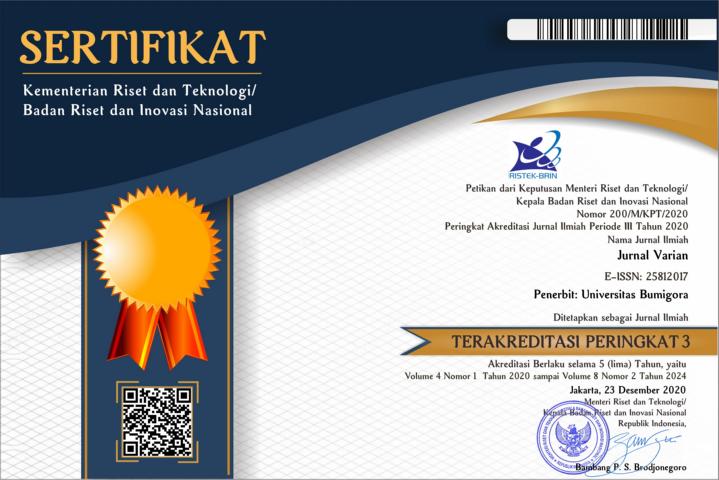Structural Equation Modeling-Partial Least Square for Poverty Modeling in Papua Province
Abstract
Poverty in Papua Province in 2018 has increased from the previous year. The poverty rate in Papua Province in March 2018 reached 27,74%. This study aims to analyze the factors that influence it so that it can be handled properly. The research method used in this research is Structural Equation Modeling (SEM) with the Partial Least Squares (PLS) approach. The research variables used consisted of 4 latent variables (Poverty, Economy, Human Resources (HR), and Health) with 16 indicators (manifest variables). Based on the analysis that has been done, it is found that economic and health variables have a negative and significant effect on poverty with path coefficients of -0,421 and -0,270, respectively. The health variable has a positive and significant effect on HR with a path coefficient of 0,496. Meanwhile, the HR variable has a positive and significant effect on the economy with a path coefficient of 0,801. It can be concluded that there are two variables that have a significant effect on poverty in Papua Province, including the economy and health.
References
Afifah, I. N. (2013). Analisis Structural Equation Model (SEM) dengan Finite Mixture Partial Least Squares (FIMIX-PLS). Penguatan Peran Matematika Dan Pendidikan Matematika Untuk Indonesia Yang Lebih Baik, November, 978–979.
Akalili S.N, & Haryono. (2014). Analisis Pengaruh Tenaga Penjualan(Marketer) Terhadap Kepuasan dan Pengaruh Kepuasan Terhadap Rekomendasi Di Perumahan “X” Dengan Metode Structural Equation Modeling-Partial Least Square. 1–8.
Asyraf, W. M., & Afthanorhan, B. W. (2013). A comparison of partial least square structural equation modeling (PLS-SEM) and covariance based structural equation modeling (CB-SEM) for confirmatory factor analysis. International Journal of Engineering Science and Innovative Technology (IJESIT), 2(5), 198–205.
Bappenas, K. P. P. N. (2018). Kedeputian Bidang Kependudukan dan Ketenagakerjaan Kementerian PPN/Bappenas.
Chin, W. W. (1998). The partial least squares approach to structural equation modelling. In Marcoulides G. A. (Ed.). Modern Methods for Business Research, 295(2), 295–336.
Cohen, J. (1988). Statistical Power Analysis for the Behavioral Science. Psychology Press.
Hair, J. F., Hult, G. T. M., Ringle, C. M., & Sarstedt, M. (2013). A Primer on Partial Least Squares Structural Equation Modeling (PLS-SEM). Thousand Oaks. In Sage.
Hair, J. F., Ringle, C. M., & Sarstedt, M. (2014). Corrigendum to “Editorial Partial Least Squares Structural Equation Modeling: Rigorous Applications, Better Results and Higher Acceptance” [LRP, 46, 1-2, (2013), 1-12], doi: Long Range Planning, 48(1–2), 1–12. https://doi.org/10.1016/j.lrp.2013.08.016
Henseler, J., Ringle, C. M., & Sinkovics, R. R. (2009). The use of partial least squares path modeling in international marketing. In R. R. Sinkovics & P. N. Ghauri (Eds.), New Challenges to International Marketing (Vol. 20, pp. 277–319). Emerald Group Publishing Limited. https://doi.org/10.1108/S1474-7979(2009)0000020014
Kafadar, K., Kotz, S., Read, C., & Banks, D. (1997). Encyclopedia of Statistical Sciences. Journal of the American Statistical Association, 92(440), 1653. https://doi.org/10.2307/2965452
Rah Adi Fahmi, G., Setyadi, S., & Suiro, U. (2018). Analisis Strategi Penanggulangan Kemiskinan di Provinsi Banten. Jurnal Ekonomi-Qu, 8(2), 227–248. https://doi.org/10.35448/jequ.v8i2.4450
Suhartini, T. (2017). Analisis Pengaruh Sumber Daya Manusia Terhadap Kemiskinan Di Provinsi Jawa Tengah. Jurnal Ekonomi Dan Teknik Informatika, 5(2), 19–27.
Vinzi, V. E., Chin, W. W., Henseler, J., & Wang, H. (2010). Handbook of Partial Least Squares. Berlin: Springer. https://doi.org/10.1016/S0021-9258(18)71293-3
Yacoub, Y. (2012). Pengaruh Tingkat Pengangguran terhadap Tingkat Kemiskinan Kabupaten / Kota di Provinsi Kalimantan Barat. 8(3), 176–185.

This work is licensed under a Creative Commons Attribution 4.0 International License.


















